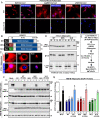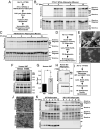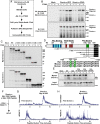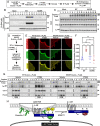Reversible lysine fatty acylation of an anchoring protein mediates adipocyte adrenergic signaling
- PMID: 35149557
- PMCID: PMC8851525
- DOI: 10.1073/pnas.2119678119
Reversible lysine fatty acylation of an anchoring protein mediates adipocyte adrenergic signaling
Abstract
N-myristoylation on glycine is an irreversible modification that has long been recognized to govern protein localization and function. In contrast, the biological roles of lysine myristoylation remain ill-defined. We demonstrate that the cytoplasmic scaffolding protein, gravin-α/A kinase-anchoring protein 12, is myristoylated on two lysine residues embedded in its carboxyl-terminal protein kinase A (PKA) binding domain. Histone deacetylase 11 (HDAC11) docks to an adjacent region of gravin-α and demyristoylates these sites. In brown and white adipocytes, lysine myristoylation of gravin-α is required for signaling via β2- and β3-adrenergic receptors (β-ARs), which are G protein-coupled receptors (GPCRs). Lysine myristoylation of gravin-α drives β-ARs to lipid raft membrane microdomains, which results in PKA activation and downstream signaling that culminates in protective thermogenic gene expression. These findings define reversible lysine myristoylation as a mechanism for controlling GPCR signaling and highlight the potential of inhibiting HDAC11 to manipulate adipocyte phenotypes for therapeutic purposes.
Keywords: HDAC11; adrenergic receptor; lysine myristoylation; signal transduction.
Copyright © 2022 the Author(s). Published by PNAS.
Conflict of interest statement
Competing interest statement: T.A.M. is on the scientific advisory boards of Artemes Bio, Inc., and Eikonizo Therapeutics, received funding from Italfarmaco for an unrelated project, and has a subcontract from Eikonizo Therapeutics related to a Small Business Innovation Research grant from the NIH (HL154959). H.L. is a founder and consultant for Sedec Therapeutics.
Figures







Similar articles
-
HDAC11 inhibition triggers bimodal thermogenic pathways to circumvent adipocyte catecholamine resistance.bioRxiv [Preprint]. 2023 Mar 30:2023.03.29.534830. doi: 10.1101/2023.03.29.534830. bioRxiv. 2023. Update in: J Clin Invest. 2023 Oct 2;133(19):e168192. doi: 10.1172/JCI168192. PMID: 37034582 Free PMC article. Updated. Preprint.
-
HDAC11 inhibition triggers bimodal thermogenic pathways to circumvent adipocyte catecholamine resistance.J Clin Invest. 2023 Oct 2;133(19):e168192. doi: 10.1172/JCI168192. J Clin Invest. 2023. PMID: 37607030 Free PMC article.
-
HDAC11 regulates type I interferon signaling through defatty-acylation of SHMT2.Proc Natl Acad Sci U S A. 2019 Mar 19;116(12):5487-5492. doi: 10.1073/pnas.1815365116. Epub 2019 Feb 28. Proc Natl Acad Sci U S A. 2019. PMID: 30819897 Free PMC article.
-
G-Protein-coupled receptor-associated A-kinase anchoring proteins: AKAP79 and AKAP250 (gravin).Eur J Cell Biol. 2006 Jul;85(7):643-50. doi: 10.1016/j.ejcb.2005.12.003. Epub 2006 Jan 26. Eur J Cell Biol. 2006. PMID: 16442664 Review.
-
An update on lysine deacylases targeting the expanding "acylome".ChemMedChem. 2014 Mar;9(3):434-7. doi: 10.1002/cmdc.201300421. Epub 2013 Dec 20. ChemMedChem. 2014. PMID: 24375937 Review.
Cited by
-
HDAC11 inhibition triggers bimodal thermogenic pathways to circumvent adipocyte catecholamine resistance.bioRxiv [Preprint]. 2023 Mar 30:2023.03.29.534830. doi: 10.1101/2023.03.29.534830. bioRxiv. 2023. Update in: J Clin Invest. 2023 Oct 2;133(19):e168192. doi: 10.1172/JCI168192. PMID: 37034582 Free PMC article. Updated. Preprint.
-
AKAP12 Upregulation Associates With PDE8A to Accelerate Cardiac Dysfunction.Circ Res. 2024 Apr 12;134(8):1006-1022. doi: 10.1161/CIRCRESAHA.123.323655. Epub 2024 Mar 20. Circ Res. 2024. PMID: 38506047 Free PMC article.
-
Membrane Association of Intrinsically Disordered Proteins.Annu Rev Biophys. 2025 May;54(1):275-302. doi: 10.1146/annurev-biophys-070124-092816. Epub 2025 Feb 14. Annu Rev Biophys. 2025. PMID: 39952269 Review.
-
HDAC11, an emerging therapeutic target for metabolic disorders.Front Endocrinol (Lausanne). 2022 Oct 20;13:989305. doi: 10.3389/fendo.2022.989305. eCollection 2022. Front Endocrinol (Lausanne). 2022. PMID: 36339432 Free PMC article. Review.
-
The cardiac METTL3/m6A pathway regulates the systemic response to Western diet.JCI Insight. 2025 Apr 24;10(11):e188414. doi: 10.1172/jci.insight.188414. eCollection 2025 Jun 9. JCI Insight. 2025. PMID: 40272887 Free PMC article.
References
-
- Resh M. D., Myristylation and palmitylation of Src family members: The fats of the matter. Cell 76, 411–413 (1994). - PubMed
MeSH terms
Substances
Associated data
Grants and funding
- R43 HL154959/HL/NHLBI NIH HHS/United States
- R01 HL127240/HL/NHLBI NIH HHS/United States
- T32 HL007822/HL/NHLBI NIH HHS/United States
- R01 HL147558/HL/NHLBI NIH HHS/United States
- P30 NS048154/NS/NINDS NIH HHS/United States
- P30 DK116073/DK/NIDDK NIH HHS/United States
- S10 RR023381/RR/NCRR NIH HHS/United States
- R15 HL141963/HL/NHLBI NIH HHS/United States
- R01 HL150225/HL/NHLBI NIH HHS/United States
- R01 DK119594/DK/NIDDK NIH HHS/United States
- R01 HL116848/HL/NHLBI NIH HHS/United States
- P30 DK048520/DK/NIDDK NIH HHS/United States
LinkOut - more resources
Full Text Sources
Molecular Biology Databases

